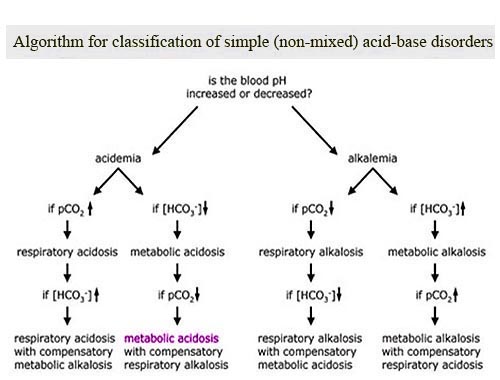Metabolic acidosis

Published: 18 Jun 2025
ICD9: 276.2 ICD10: E87.2 ICD11: 5C73
Metabolic acidosis is a condition that occurs when there is too much acid in the body fluids.
It's a disruption of the body's acid-base balance.
Here's a breakdown:
![]() What it is: It's a decrease in blood pH (making it more acidic) due to either:
What it is: It's a decrease in blood pH (making it more acidic) due to either:![]()

![]() A loss of bicarbonate (HCO3-): Bicarbonate is a base that helps neutralize acids in the body. Losing it means the body can't buffer acids as effectively.
A loss of bicarbonate (HCO3-): Bicarbonate is a base that helps neutralize acids in the body. Losing it means the body can't buffer acids as effectively.![]()

![]() An increase in acid production: The body creates or retains too much acid, overwhelming the body's buffering capacity.
An increase in acid production: The body creates or retains too much acid, overwhelming the body's buffering capacity.![]()

![]() Impaired acid excretion: The kidneys can't remove acids from the body as efficiently.
Impaired acid excretion: The kidneys can't remove acids from the body as efficiently.
![]() Normal pH range: Normal blood pH is tightly regulated between 7.35 and 7.45. In metabolic acidosis, the pH falls below 7.35.
Normal pH range: Normal blood pH is tightly regulated between 7.35 and 7.45. In metabolic acidosis, the pH falls below 7.35.
![]() Causes: Metabolic acidosis can have many different underlying causes, including:
Causes: Metabolic acidosis can have many different underlying causes, including:![]()

![]() Kidney problems: Kidney failure, renal tubular acidosis (RTA)
Kidney problems: Kidney failure, renal tubular acidosis (RTA)![]()

![]() Diabetic ketoacidosis (DKA): A complication of diabetes where the body produces too many ketones (acids) due to lack of insulin.
Diabetic ketoacidosis (DKA): A complication of diabetes where the body produces too many ketones (acids) due to lack of insulin.![]()

![]() Lactic acidosis: Buildup of lactic acid, often due to shock, sepsis, severe heart failure, or strenuous exercise.
Lactic acidosis: Buildup of lactic acid, often due to shock, sepsis, severe heart failure, or strenuous exercise.![]()

![]() Severe diarrhea: Loss of bicarbonate from the intestines.
Severe diarrhea: Loss of bicarbonate from the intestines.![]()

![]() Ingestion of certain toxins or drugs: Such as methanol, ethylene glycol (antifreeze), aspirin overdose.
Ingestion of certain toxins or drugs: Such as methanol, ethylene glycol (antifreeze), aspirin overdose.![]()

![]() Severe dehydration: Can lead to decreased kidney function and acid buildup.
Severe dehydration: Can lead to decreased kidney function and acid buildup.![]()

![]() Hyperchloremic acidosis: Occurs when there is an excess of chloride in the blood, often due to excessive saline infusion or certain medications.
Hyperchloremic acidosis: Occurs when there is an excess of chloride in the blood, often due to excessive saline infusion or certain medications.
![]() Symptoms: The symptoms of metabolic acidosis vary depending on the severity and underlying cause. Common symptoms may include:
Symptoms: The symptoms of metabolic acidosis vary depending on the severity and underlying cause. Common symptoms may include:![]()

![]() Rapid, shallow breathing (body trying to blow off CO2)
Rapid, shallow breathing (body trying to blow off CO2)![]()

![]() Fatigue
Fatigue![]()

![]() Headache
Headache![]()

![]() Confusion
Confusion![]()

![]() Nausea and vomiting
Nausea and vomiting![]()

![]() Loss of appetite
Loss of appetite![]()

![]() Weakness
Weakness![]()

![]() In severe cases: Coma, shock, and death
In severe cases: Coma, shock, and death
![]() Diagnosis: Diagnosed with an arterial blood gas (ABG) test. The ABG measures the pH, partial pressure of carbon dioxide (PaCO2), and bicarbonate (HCO3-) levels in the blood. Electrolyte panels and other blood tests can help determine the underlying cause.
Diagnosis: Diagnosed with an arterial blood gas (ABG) test. The ABG measures the pH, partial pressure of carbon dioxide (PaCO2), and bicarbonate (HCO3-) levels in the blood. Electrolyte panels and other blood tests can help determine the underlying cause.
![]() Treatment: Treatment focuses on correcting the underlying cause and restoring the acid-base balance. This might involve:
Treatment: Treatment focuses on correcting the underlying cause and restoring the acid-base balance. This might involve:![]()

![]() Addressing the underlying medical condition: Treating kidney failure, managing diabetes, etc.
Addressing the underlying medical condition: Treating kidney failure, managing diabetes, etc.![]()

![]() Administering bicarbonate: In some cases, bicarbonate may be given intravenously to neutralize the excess acid. However, it's not always appropriate and must be carefully monitored.
Administering bicarbonate: In some cases, bicarbonate may be given intravenously to neutralize the excess acid. However, it's not always appropriate and must be carefully monitored.![]()

![]() Fluid and electrolyte management: Correcting dehydration and electrolyte imbalances.
Fluid and electrolyte management: Correcting dehydration and electrolyte imbalances.![]()

![]() Dialysis: May be needed in cases of severe kidney failure.
Dialysis: May be needed in cases of severe kidney failure.![]()

![]() Supportive care: Monitoring vital signs and providing other necessary medical support.
Supportive care: Monitoring vital signs and providing other necessary medical support.
Important Considerations:
![]() Metabolic acidosis is a serious medical condition that requires prompt diagnosis and treatment.
Metabolic acidosis is a serious medical condition that requires prompt diagnosis and treatment.
![]() The specific treatment depends on the cause and severity of the acidosis.
The specific treatment depends on the cause and severity of the acidosis.
![]() It's crucial to consult with a doctor for proper evaluation and management.
It's crucial to consult with a doctor for proper evaluation and management.
In Summary: Metabolic acidosis is an electrolyte disorder caused by an accumulation of acid in the body. This accumulation can occur due to increased acid production, decreased acid excretion, or loss of bicarbonate. Treatment depends on the cause, and it is important to consult a medical professional if you suspect you or someone you know has this condition.